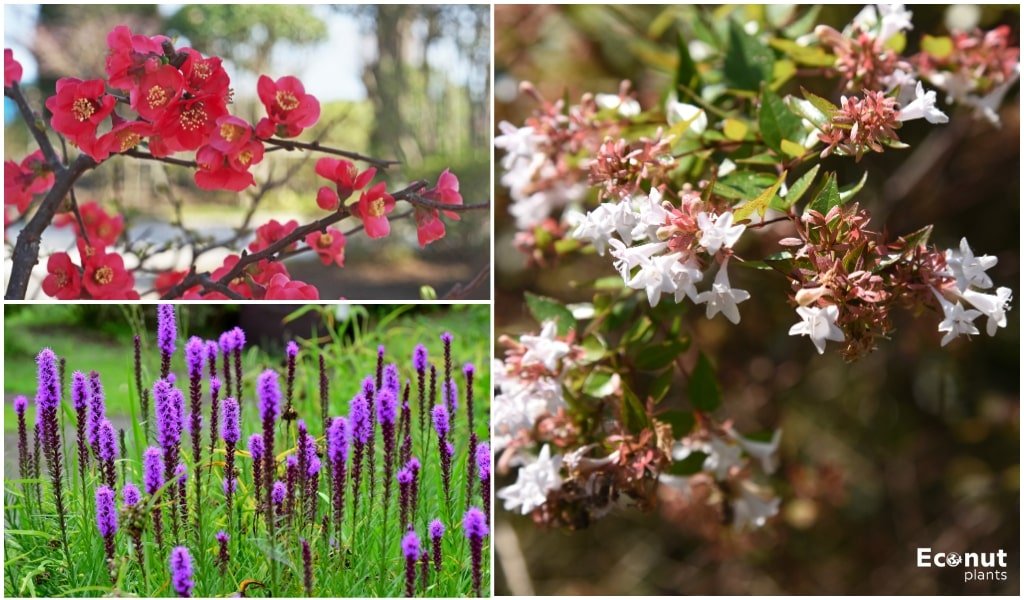Looking for vibrant, low-maintenance plants to bask in the full sun? Here’s a preview of the delightful greenery we’ll explore in this article.
Whether you’re a seasoned gardener or just starting, these plants are sure to thrive with minimal fuss. Let’s dive in and discover your next sunny garden companions!
1. Daylily
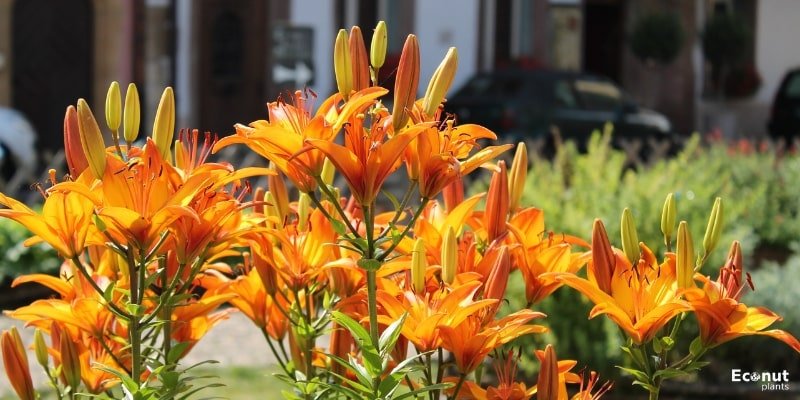 Scientific Name: Hemerocallis lilioasphodelus
Scientific Name: Hemerocallis lilioasphodelus
Sun Exposure: Full Sun, Part shade
Plant Type: Herbaceous perennial
Plant Size: 1-3 feet
Hardiness Zone: 4-10
For many good reasons, daylilies have been around for a very long time. They tolerate a wide range of environments, are hardy, low-maintenance, easy to grow, and attractive.
However, because of their tendency to proliferate, they can be considered invasive in certain regions. They are typically very controllable in a residential landscape.
2. Lavender
 Scientific Name: Lavandula
Scientific Name: Lavandula
Sun Exposure: Full Sun, Part shade
Plant Type: perennial
Plant Size: 1-3 feet
Hardiness Zone: 5-9
Lavender is a sun-loving plant that does best in direct sunshine. For best growth and blooming, it needs six to eight hours of direct sunlight each day. Lavender will grow healthily and produce bright blooms if it is planted in an area that receives lots of sunshine, like a garden bed facing south or a sunny walkway.
Lavender plants thrive in full sun and continue to grow densely and fragrantly. Even in full sun, lavender plants can suffer from too much moisture, so it’s critical to have well-drained soil to avoid root rot. Lavender may flourish and enhance the beauty and scent of your garden with the correct amount of sunlight and well-drained soil.
3. Abelia
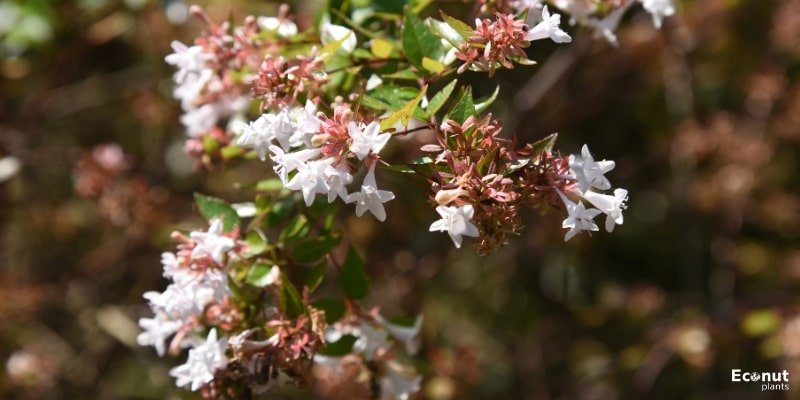 Scientific Name: Abelia x grandiflora
Scientific Name: Abelia x grandiflora
Sun Exposure: Full Sun, Part shade
Plant Type: Shrub
Plant Size: 3-6 feet
Hardiness Zone: 5-9
Abelia plants indeed thrive in full sun to partial shade. They generally prefer a location with full sun exposure, meaning they should receive at least six hours of direct sunlight per day for optimal growth and blooming.
However, they can tolerate some shade, particularly in hot climates, but they may produce fewer flowers in such conditions. It’s always a good idea to check the specific sunlight requirements for the variety of Abelia you have, as different cultivars might have slightly different preferences.
4. Agapanthus
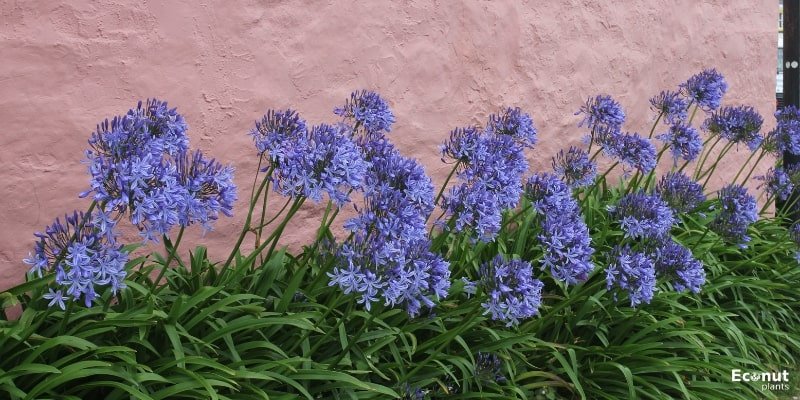 Scientific Name: Agapanthus spp.
Scientific Name: Agapanthus spp.
Sun Exposure: Full Sun
Plant Type: perennial plants
Plant Size: 5 feet
Hardiness Zone: 8-11
Agapanthus, also known as Lily of the Nile, is native to southern Africa and can grow evergreen in USDA Plant Hardiness Zones 8 through 11. This summertime bloom that loves the sun looks great in a pot on your patio or as a border along walkways.
Although it requires well-draining soil, agapanthus grows best with weekly irrigation. It will keep flowering throughout the fall in places that don’t get frost. Although other species can tolerate neutral or slightly alkaline soil, A. africanus favours acidic soil.
5. Zinnia
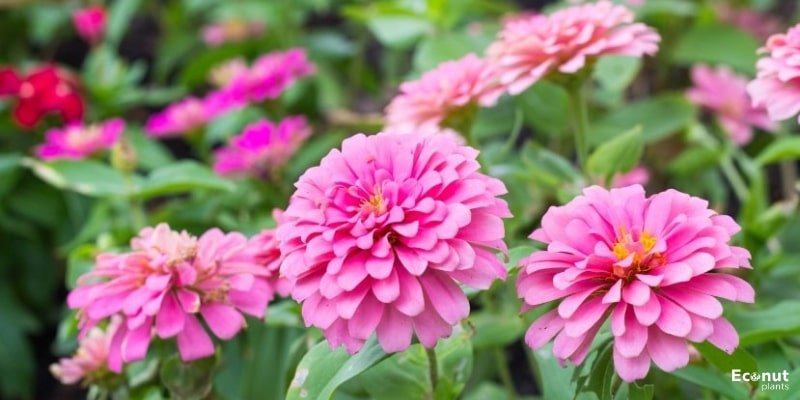 Scientific Name: Zinnia elegans
Scientific Name: Zinnia elegans
Sun Exposure: Full Sun
Plant Type: Annual
Plant Size: 1-5 feet
Hardiness Zone: 2-11
Zinnias thrive in areas that are extremely warm and receive full sun for at least eight hours each day. They may be more prone to disease and produce fewer flowers, but they may withstand some partial shade, particularly in warmer climates with afternoon shade.
6. Black-Eyed Susan
 Scientific Name: Rudbeckia hirta
Scientific Name: Rudbeckia hirta
Sun Exposure: Full Sun, Part Sun
Plant Type: Perennial plant
Plant Size: 1-3 feet
Hardiness Zone: 3-10
One of the easiest flowers to grow in direct sunshine is the black-eyed Susan. This short-lived wildflower can be found on roadsides, open forests, prairies, and fields.
It spreads swiftly by self-seeding. Flowers with yellow petals encircling a brownish-black core, like daisies, bloom in late summer and early fall. A longer blooming season is encouraged by deadheading.
7. Panicle Hydrangea
 Scientific Name: Hydrangea paniculata
Scientific Name: Hydrangea paniculata
Sun Exposure: Full Sun, Part Sun
Plant Type: Shrub
Plant Size: 8-15 feet
Hardiness Zone: 3-8
The fluffy clusters of flowers that the hydrangea panicle produces come in a variety of colours. This is a bigger plant that can grow to a height of 8 to 15 feet.
If you decide to cultivate panicle hydrangeas, make sure the area you choose for the plants to develop receives four or more hours of sunlight each day. The plant blooms more the more sun it receives. Any type of well-draining soil is necessary for panicle hydrangeas. This hydrangea cultivar may be grown in planting zones three through eight.
8. Russian Sage
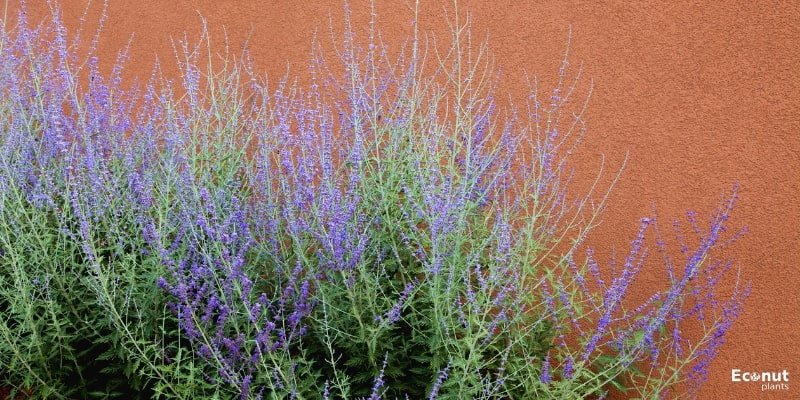 Scientific Name: Perovskia atriplicifolia
Scientific Name: Perovskia atriplicifolia
Sun Exposure: Full Sun
Plant Type: Perennial plant
Plant Size: 2-4 feet
Hardiness Zone: 4-9
One of my favourite full-sun plants is Russian Sage, with its gorgeous purple flowers and gray-green foliage. These perennial plants attract hummingbirds, butterflies, and bees in addition to being drought- and deer-tolerant.
They also require no maintenance at all and may thrive in almost any type of soil. It doesn’t require splitting, deadheading, or fertilization. If you would like to regulate its size, you can trim it shorter in the spring, but that is also not required.
9. Marigold
 Scientific Name: Tagetes patula
Scientific Name: Tagetes patula
Sun Exposure: Full Sun
Plant Type: Annual
Plant Size: 0.5-1.5 feet
Hardiness Zone: 2-11
Excellent border plants, marigolds can survive full sun exposure and yet appear as fresh as a flower. Plant this flower in window boxes or on the edge of your yard, as its odor discourages deer and rabbits.
Marigolds tolerate quite a bit of drought, don’t mind a little bit of soil, and frequently bloom until the first fall frost. Although some species of marigolds are perennial, most are annuals.
10. Lantana
 Scientific Name: Lantana camara var.
Scientific Name: Lantana camara var.
Sun Exposure: Full Sun
Plant Type: shrub
Plant Size: 3-6 feet
Hardiness Zone: 7-10
The lantana is a visually arresting annual that produces small, spherical clusters of blooms with lovely colour variations that resemble rainbows. The plants can withstand arid conditions and resemble shrubs.
11. Flowering Quince
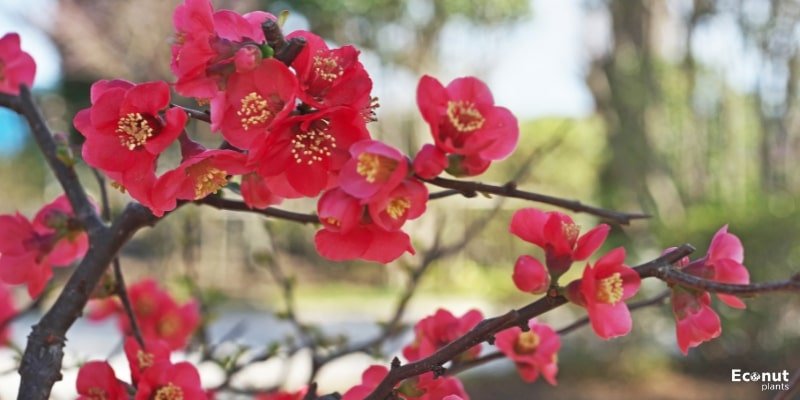 Scientific Name: Chaenomeles speciosa
Scientific Name: Chaenomeles speciosa
Sun Exposure: Full Sun, Part Sun
Plant Type: Shrub
Plant Size: 6-10 feet
Hardiness Zone: 4-8
Early to mid-spring is when this lovely shrub reaches its peak bloom, coinciding with many other plants beginning to wake. Growing flowering quince in full sun or light shade is not difficult.
Though it can tolerate a variety of soil types, this well-known plant loves well-drained, medium-moisture soil. You don’t need to perform any significant pruning other than removing any dead or straggly branches as needed because plants thrive on old wood.
A great plant for borders, hedges, or as a standalone shrub is the flowering quince. The vivid pinkish-red blossoms are abundant and ostentatious.
12. Dianthus
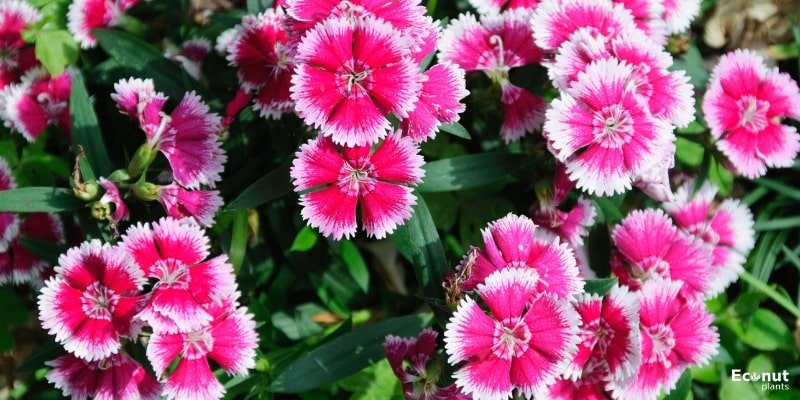 Scientific Name: Dianthus gratianofolitanus ‘Grandiflorus’
Scientific Name: Dianthus gratianofolitanus ‘Grandiflorus’
Sun Exposure: Full Sun
Plant Type: Perennial
Plant Size: 6-12 feet
Hardiness Zone: 3-8
Dianthus is a broad family of pretty flowers for cottage gardens, which includes carnations, sweet Williams, and cheddar pinks. Depending on the species, they could bloom in the spring or the summer.
In full sun and well-draining, organically rich soil, dianthus grows well in Zones 4–9. Though they are pretty careless when planted in a favourable spot, the plants still require frequent watering during the summer.
13. Daffodil
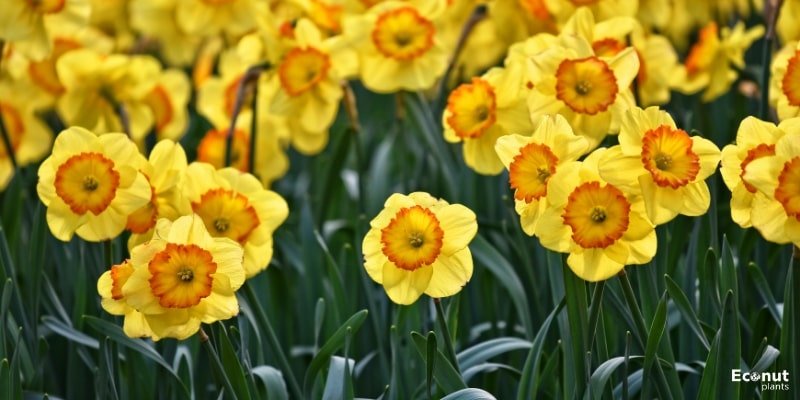 Scientific Name: Narcissus var.
Scientific Name: Narcissus var.
Sun Exposure: Full Sun
Plant Type: Bulb
Plant Size: 0.5-2 feet
Hardiness Zone: 4-8
Daffodil season is in spring. Daffodils bloom in a spectrum of white, yellow, and orange hues, including an almost pink orange. These colourful bulbs are widely accessible and very simple to cultivate.
Just sow them in the spring or fall, about 3 to 5 inches deep, in a sunny spot, cover them with dirt, and wait for them to blossom. In addition to being resilient to deer and rabbits, daffodils can also withstand dry and clay soils, as well as being dug up and relocated annually.
Daffodils are among the first flowers to emerge every spring. They start their annual cycle with a few long, green leaves that resemble grass. A tall, green flower stalk will soon appear after the leaves appear, and when it reaches its maximum height, the bud will open, giving you a glimpse of some visually appealing foliage.
Cut daffodils make wonderful arrangements. The bulbs will grow underground each year, and before you know it, gorgeous bunches of vibrant springtime blooms will be yours.
14. Coneflowers
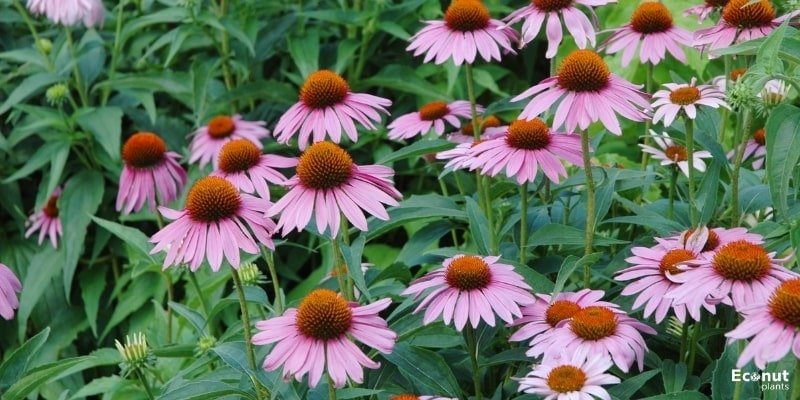 Scientific Name: Echinacea
Scientific Name: Echinacea
Sun Exposure: Full Sun
Plant Type: Perennial
Plant Size: 2-5 feet
Hardiness Zone: 3-9
Coneflowers are unique in shape and hard to miss. These lovely plants have colourful petals that fall to reveal a protruding center. Consequently, the plant develops a cone-like form.
Make sure the soil in the area where you are planting coneflowers drains well and receives full sunlight. Coneflowers are hardy in planting zones three through nine and are perennial plants.
15. Blazing Star
 Scientific Name: Liatris spp.
Scientific Name: Liatris spp.
Sun Exposure: Full Sun
Plant Type: Perennial
Plant Size: 2–4 feet
Hardiness Zone: 3-9
You have everything you need for the blazing sun in Blazing Star. Though you can get white and pink variations, these prickly pollinator plants are often purple.
In dry, poor soils, a wide variety of blazing stars thrive. Although it can withstand more moisture and flourish in rain gardens, the commonly available L. spicata prefers well-drained soil.
16. Azalea
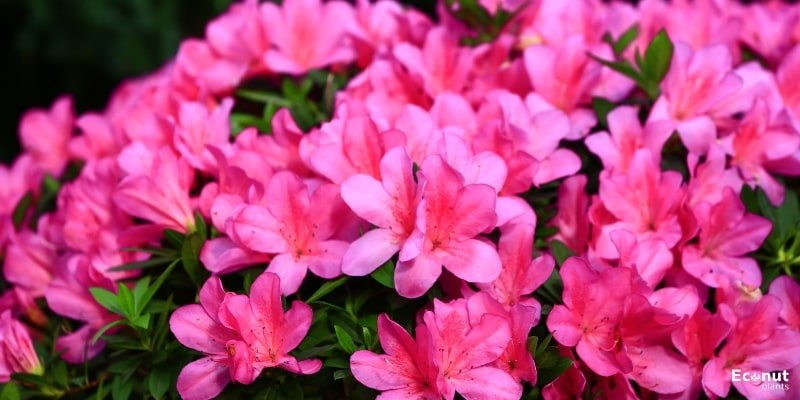 Scientific Name: Rhododendron var.
Scientific Name: Rhododendron var.
Sun Exposure: Full Sun
Plant Type: Evergreen
Plant Size: 3–6 feet
Hardiness Zone: 5-9
Azaleas come in a wide variety, with many suitable for low-maintenance landscapes that home gardeners can create. Make sure your selected azalea will thrive in the climate zone and environmental circumstances that suit it.
Although some may be better suited for warmer or colder climes, most azaleas planted in nurseries will thrive well in zones 5 through 9. Grow azaleas in soil that is slightly acidic and well-drained in full sun. Keep the soil moist and check it frequently because azaleas dislike it when it gets too dry.
Spring-blooming shrubs that are dependable are azaleas. Beautiful and vivid flower arrangements are displayed. The plant is covered in dense clusters of big, eye-catching blooms that appear in colours of pink or white, forming a bushy mound. A visually striking annual display, flowers also draw pollinators.
17. Aloe Vera
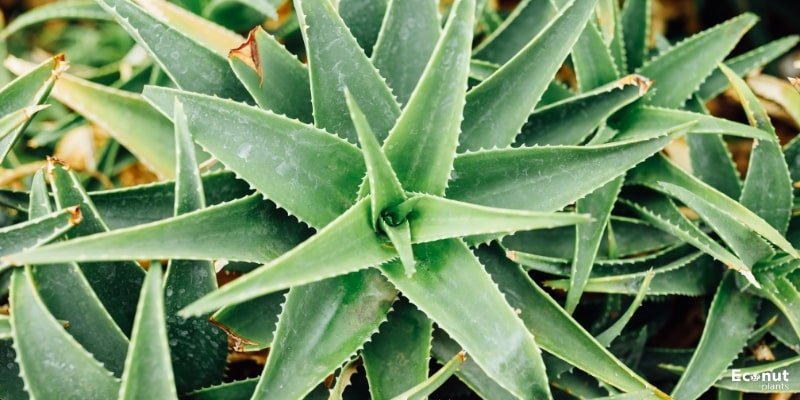 Scientific Name: Aloe vera
Scientific Name: Aloe vera
Sun Exposure: Full Sun
Plant Type: perennial
Plant Size: 1–2 feet
Hardiness Zone: 9-10
Aloe plants are an excellent place to start if you’re looking for a plant that does well left to its own devices in the sunlight. Aloes are a great option for any backyard this summer, as they’re among the greatest low-maintenance full-sun plants available.
It requires six hours or more of direct sunlight per day, yet it can withstand almost any kind of environment. Just watch out not to submerge it too much!
18. Yarrow
 Scientific Name: Achillea millefolium
Scientific Name: Achillea millefolium
Sun Exposure: Full Sun
Plant Type: Perennial
Plant Size: 2-3
Hardiness Zone: 3-9
In your garden, yarrow is the perfect plant for any rocky, sandy, or dry region that receives lots of sunlight. Yarrow produces flat clusters of flowers that are usually white or gold in colour, along with ferny, medicinal-smelling foliage. Now, there are purple, red, and pink hybrids available. You can arrange the dried flowers.
19. Madagascar Periwinkle
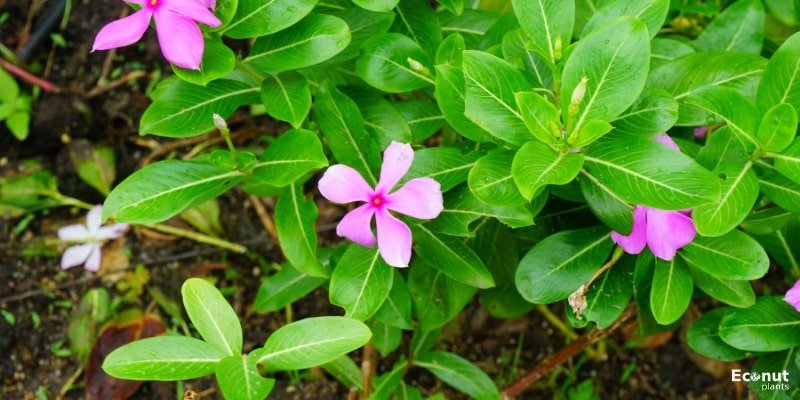 Scientific Name: Catharanthus roseus
Scientific Name: Catharanthus roseus
Sun Exposure: Full Sun
Plant Type: Perennial
Plant Size: 2 feet
Hardiness Zone: 6-9
These bushy plants are popular in summer pots, hanging baskets, and borders. They are native to Madagascar, India, and tropical Asia, and they thrive in both dry and humid temperatures.
White or red eyes adorn the pristine white, pink, rose, or white blossoms. Many still refer to the flower as Vinca, even though its botanical name was once Vinca rosea.
20. Sedum
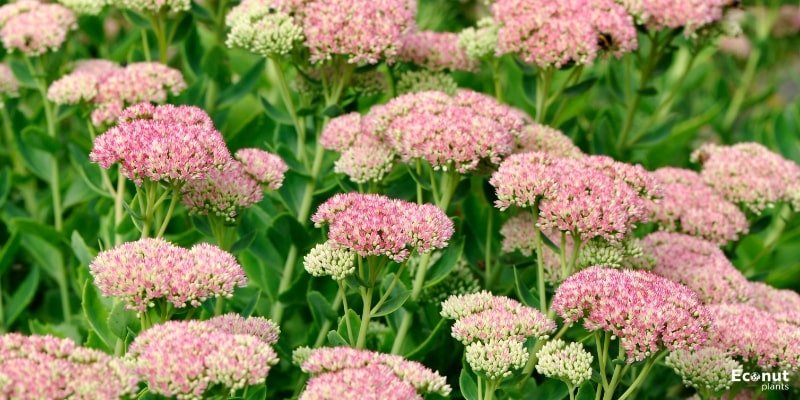 Scientific Name: Sedum
Scientific Name: Sedum
Sun Exposure: Full Sun
Plant Type: Perennial
Plant Size: 2 feet
Hardiness Zone: 3-11
Sedum is a plant that is hard to overlook. It yields tiny blossoms that assemble into clusters to form bigger, more vibrant blooms. This low-maintenance plant, also referred to as a stonecrop, simply needs a growing spot with full to partial sunlight and soil that drains well.
Disease problems may arise if the soil stays oversaturated at any point. Plant zones three through eleven should continue to support the hardiness of perennial sedum.
21. Bee Balm
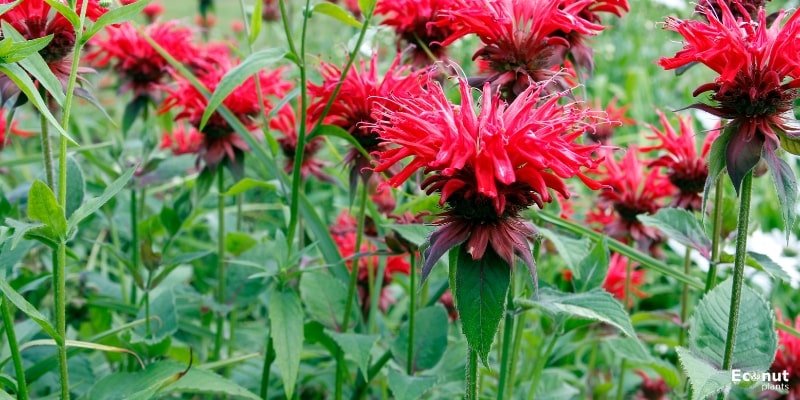 Scientific Name: Monarda
Scientific Name: Monarda
Sun Exposure: Full Sun
Plant Type: Perennial
Plant Size: 4 feet
Hardiness Zone: 3-9
The sun-loving perennial bee balm (Monarda) grows easily and produces pink, white, red, or purple blossoms. Hummingbirds, butterflies, and bees are drawn to its vividly colourful blossoms with tubular-shaped petals.
In the fall and winter, the birds eat the seed heads of this plant. After the initial round of blooms, deadhead the flowers to stimulate a second flush later in the summer.
To avoid powdery mildew, which doesn’t normally harm the plant but doesn’t look nice, bee balm needs plenty of air circulation.

